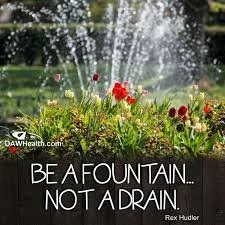I’ve been working in collaborations for over four decades, and in that time, I’ve seen some incredible successes and some frustrating failures. The common thread that separates the two is usually never just about resources, strategy, or even raw talent. It’s often about attitude and mindset.
Think about a collaboration you’ve been a part of. What was the energy like? Was it a group of people pulling together, sharing ideas freely, and celebrating small wins? Or was it a constant battle for attention and resources, bogged down by complaints and a sense of scarcity?
This is where the idea of fountains vs. drains comes in, and it's a powerful lens through which to view any collaborative effort.
Fountains are those invaluable team members who grow the pie. They don't just focus on their piece; they look for ways to make the whole pie bigger, so everyone benefits. They lift others up, offering a word of encouragement, a helpful suggestion, or a hand with a difficult task. When a problem arises, they’re the first to offer solutions, not just point out what’s wrong. They give freely of their time and expertise, understanding that their generosity is an investment in the group's shared success. Above all, they have a positive attitude, seeing challenges as opportunities and setbacks as temporary hurdles. Fountains are people who have growth, abundance and positive mindsets.
On the other hand, drains do the opposite, they have fixed mindsets, see scarcity and live in the negative. They complain about everything—the timeline, the budget, the lack of support. They are focused on grabbing their slice, always concerned with what they can get for themselves, often at the expense of others. Their mindset is defined by "what’s in it for me?" They are constantly taking, whether it's credit for an idea or more than their fair share of resources. Their negative attitude creates a downward pull, sapping the energy and enthusiasm from the room.
A collaboration with more fountains than drains is a powerful force. It becomes a virtuous cycle where positive energy, creativity, and mutual support build on each other. When people feel safe to share ideas and know their contributions are valued, they are more engaged and innovative. The team becomes more resilient, capable of overcoming unexpected obstacles because they trust each other.
Conversely, a team with too many drains will struggle, no matter how good the initial idea or plan. Their negativity and self-interest create friction, erode trust, and stifle creativity. The collaboration becomes a zero-sum game, and everyone loses in the end.
Cultivating a Fountain Mindset
The great news is that being a fountain isn't a personality trait you're born with; it’s a mindset you can cultivate through conscious practice. It starts with a vital dose of self-awareness. When you enter a meeting or a new project, take a moment to reflect on your default behaviour. Are you the one offering solutions or just pointing out problems? Are you celebrating a partner's success or secretly viewing it as a threat to your own? Recognizing your patterns is the most crucial step.
Once you’ve identified where you tend to fall, be intentional about your actions. Practice catching yourself before you complain, and instead, re-frame that thought into a potential solution. For example, instead of thinking, "This timeline is impossible," ask, "How might we adjust our approach to meet this deadline more effectively?"
You can also start small. Practice active listening, not just waiting for your turn to speak. The simple act of truly hearing someone out builds respect and trust. Offer a genuine compliment to a colleague on their recent work. These small acts of generosity build momentum.
Think of this as building a muscle. The more you choose to act like a fountain—by offering, uplifting, and contributing—the more natural it becomes. Over time, you’ll find that a positive, collaborative mindset isn't just a strategy for success; it’s a more fulfilling way to work and live. It’s a choice that elevates not just your work, but the work of everyone around you.
So, as you go into your next collaboration, ask yourself: Am I a fountain or a drain?


